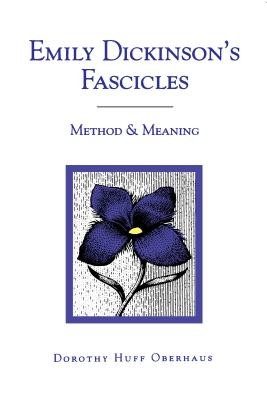
- We will send in 10–14 business days.
- Author: Dorothy Oberhaus
- Publisher: Penn State University Press
- ISBN-10: 0271025638
- ISBN-13: 9780271025636
- Format: 15.9 x 22.8 x 1.8 cm, softcover
- Language: English
- SAVE -10% with code: EXTRA
Reviews
Description
Emily Dickinson's fascicles, the forty booklets comprising more than 800 of her poems that she gathered and bound together with string, had long been cast into disarray until R. W. Franklin restored them to their original state, then made them available to readers in his 1981 Manuscript Books of Emily Dickinson. Many Dickinson readers believe their ordering to be random, while others have proposed that one or more of the fascicles appear to center upon some organizing principle.
In this important critical study, Dorothy Huff Oberhaus demonstrates for the first time the structural principles underlying Emily Dickinson's assembling of the fascicles. Oberhaus argues that Dickinson's fortieth fascicle is a three-part meditation and the triumphant conclusion of a long lyric cycle, the account of a spiritual and poetic pilgrimage that begins with the first fascicle's first poem. The author in turn finds that the other thirty-eight fascicles are meditative gatherings of interwoven poems centering upon common themes.
Discovering the structural principles underlying Dickinson's arrangement of the fascicles presents a very different poet from the one portrayed by previous critics. This careful reading of the fascicles reveals that Dickinson was capable of arranging a long, sustained major work with the most subtle and complex organization. Oberhaus also finds Dickinson to be a Christian poet for whom the Bible was not merely a source of imagery, as has long been thought; rather, the Bible is essential to Dickinson's structure and meaning and therefore an essential source for understanding her poems.
Discovering the structural principles underlying Dickinson's arrangement of the fascicles presents a very different poet from the one portrayed by previous critics. This careful reading of the fascicles reveals that Dickinson was capable of arranging a long, sustained major work with the most subtle and complex organization. Oberhaus also finds Dickinson to be a Christian poet for whom the Bible was not merely a source of imagery, as has long been thought; rather, the Bible is essential to Dickinson's structure and meaning and therefore an essential source for understanding her poems.
EXTRA 10 % discount with code: EXTRA
The promotion ends in 16d.05:54:18
The discount code is valid when purchasing from 10 €. Discounts do not stack.
- Author: Dorothy Oberhaus
- Publisher: Penn State University Press
- ISBN-10: 0271025638
- ISBN-13: 9780271025636
- Format: 15.9 x 22.8 x 1.8 cm, softcover
- Language: English English
Emily Dickinson's fascicles, the forty booklets comprising more than 800 of her poems that she gathered and bound together with string, had long been cast into disarray until R. W. Franklin restored them to their original state, then made them available to readers in his 1981 Manuscript Books of Emily Dickinson. Many Dickinson readers believe their ordering to be random, while others have proposed that one or more of the fascicles appear to center upon some organizing principle.
In this important critical study, Dorothy Huff Oberhaus demonstrates for the first time the structural principles underlying Emily Dickinson's assembling of the fascicles. Oberhaus argues that Dickinson's fortieth fascicle is a three-part meditation and the triumphant conclusion of a long lyric cycle, the account of a spiritual and poetic pilgrimage that begins with the first fascicle's first poem. The author in turn finds that the other thirty-eight fascicles are meditative gatherings of interwoven poems centering upon common themes.
Discovering the structural principles underlying Dickinson's arrangement of the fascicles presents a very different poet from the one portrayed by previous critics. This careful reading of the fascicles reveals that Dickinson was capable of arranging a long, sustained major work with the most subtle and complex organization. Oberhaus also finds Dickinson to be a Christian poet for whom the Bible was not merely a source of imagery, as has long been thought; rather, the Bible is essential to Dickinson's structure and meaning and therefore an essential source for understanding her poems.
Discovering the structural principles underlying Dickinson's arrangement of the fascicles presents a very different poet from the one portrayed by previous critics. This careful reading of the fascicles reveals that Dickinson was capable of arranging a long, sustained major work with the most subtle and complex organization. Oberhaus also finds Dickinson to be a Christian poet for whom the Bible was not merely a source of imagery, as has long been thought; rather, the Bible is essential to Dickinson's structure and meaning and therefore an essential source for understanding her poems.


Reviews